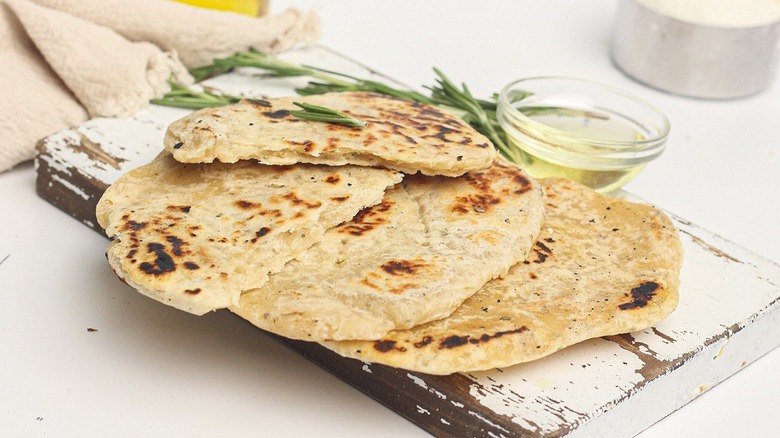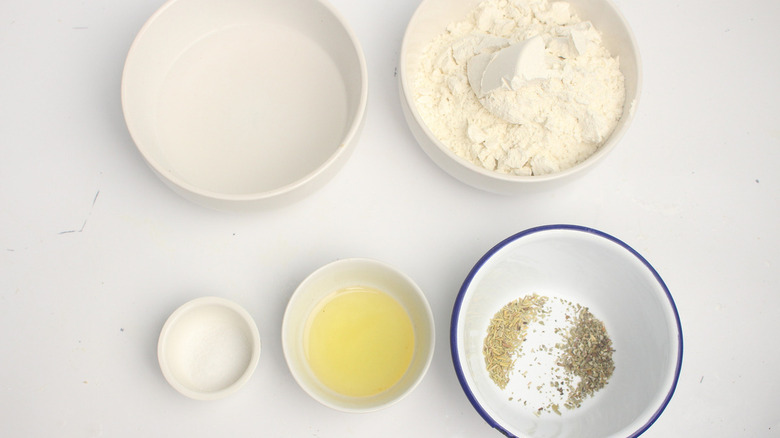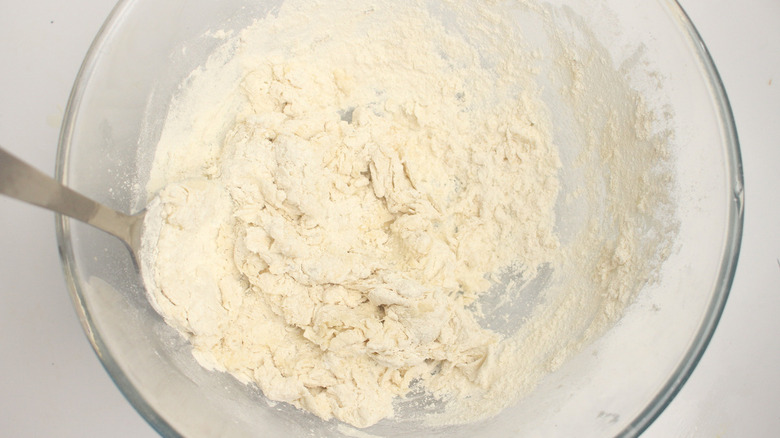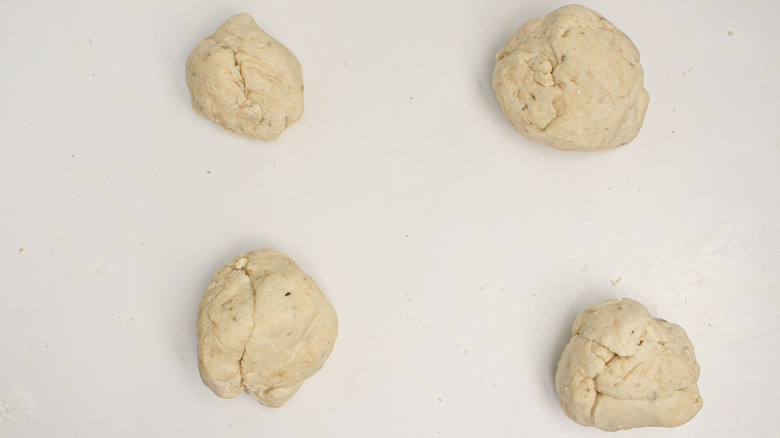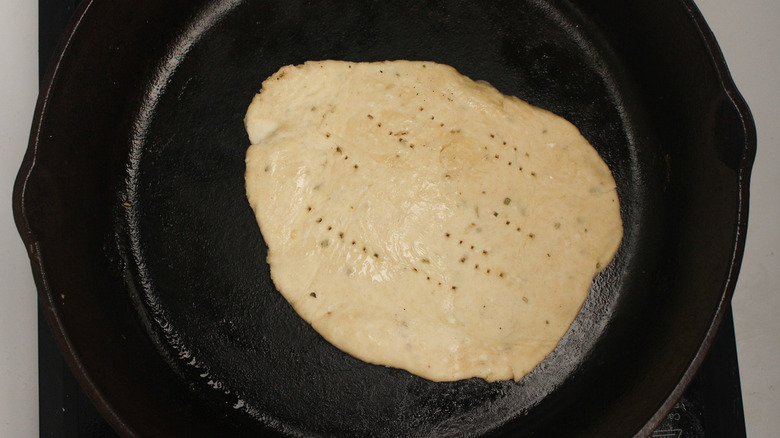Herbed Unleavened Bread Recipe
While the term unleavened bread is often explained as being bread made without yeast, it's actually made without any type of leavening agent at all. This means that the term does not apply to quick breads as these will rise thanks to ingredients such as baking powder. Unleavened breads, however, do not rise at all, so their most distinctive characteristic is their flatness. The genre is a wide-ranging one, encompassing as it does flatbreads ranging from the Scandinavian potato-based lefse to tortillas to matzah. "Unleavened breads are common in many cuisines, including Indian, Jewish, and Middle Eastern cuisine," recipe developer Susan Olayinka explains.
Olayinka also offers some insight into the texture and consistency of the bread. She notes that omitting the leavening "results in a denser, harder bread," which is why flatbreads make a great base for pizzas and other such toppings. She also notes that unleavened bread is very easy to make, describing it as "perfect for those who are looking for a simple and delicious bread recipe that doesn't require any rising time." One thing about her flatbread that makes it different from plainer recipes, however, is the herbs she likes to use. As she explains, "the addition of oregano, rosemary, and other herbs give [this bread] a unique flavor."
Assemble the ingredients for the unleavened bread
The only ingredients you need for this unleavened bread are items you may have on hand in the pantry. For the bread itself, you'll be using all-purpose flour, water, olive oil, and salt, plus some dried rosemary and oregano for the herbed seasoning. Olayinka notes that the herbs are what makes this recipe truly special: "Unleavened bread is usually plain, but the addition of oregano, rosemary, [or] other herbs give it a unique flavor."
Make the dough
Mix the herbs into the flour along with the salt. Stir the oil and water into the dry ingredients and keep on stirring until the mixture forms a dough. Knead the dough for 3 minutes, at which point it should begin to cohere into a ball and will appear relatively smooth.
Shape the dough
Divvy up the dough into four equal pieces, then roll each one into a ball. Put the balls on an ungreased flat work surface, then roll them out until each one is about ¼-inch thick.
Cook the flatbreads
Heat up a skillet over medium heat. Working with one piece of dough at a time, carefully transfer it to the pan and cook it for 2 minutes or until it is golden brown on the bottom. Flip it and cook it for about another 2 minutes, at which point it should be golden brown all over. Olayinka cautions "Be careful not to overcook the bread," explaining that should you do so, "It will become dry and tough." Repeat the cooking process with the remaining three pieces of dough.
Wondering what to do with your newly-created flatbreads? WelI, you could use them to make pizzas, although Olayinka notes that they "would also be great with some dipping sauces or spreads like hummus or tapenade" and says they could be used to accompany soups or stews, as well.
Herbed Unleavened Bread Recipe
This herbed unleavened bread recipe makes for the perfect flatbread or pizza base.
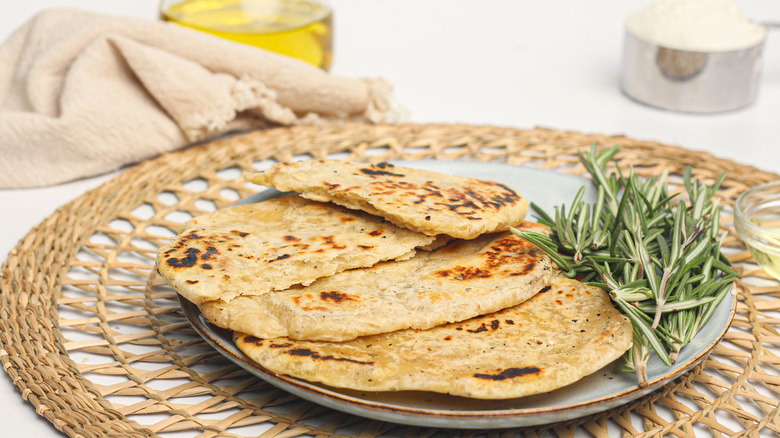
Ingredients
- 1 ½ cups all-purpose flour
- ½ teaspoon salt
- 1 tablespoon dried oregano
- 1 teaspoon dried rosemary
- 2 tablespoons olive oil
- ½ cup water
Directions
- Combine the flour, salt, oregano, and rosemary.
- Stir the oil and water into the dry ingredients until the mixture forms a dough.
- Knead the dough for about 3 minutes, until it forms a smooth ball.
- Divide the dough into 4 pieces and roll each one into a ball.
- Place the dough balls on an ungreased work surface.
- Roll each piece of dough out to ¼-inch thickness.
- Heat a skillet over medium heat.
- Cook each dough round one at a time for 2 minutes per side (4 minutes in all), or until they appear golden brown.
Nutrition
| Calories per Serving | 233 |
| Total Fat | 7.3 g |
| Saturated Fat | 1.0 g |
| Trans Fat | 0.0 g |
| Cholesterol | 0.0 mg |
| Total Carbohydrates | 36.5 g |
| Dietary Fiber | 1.7 g |
| Total Sugars | 0.2 g |
| Sodium | 196.0 mg |
| Protein | 4.9 g |
